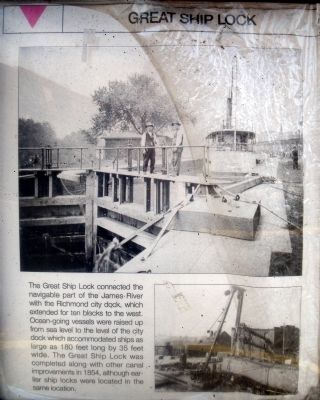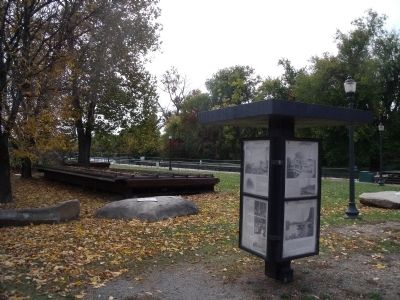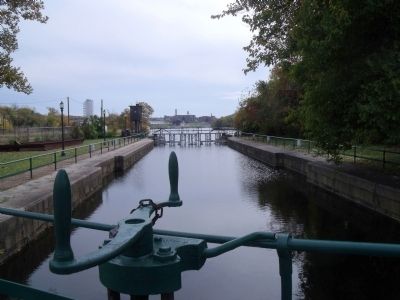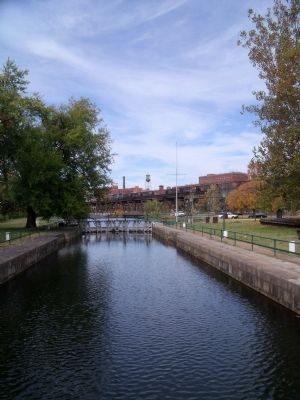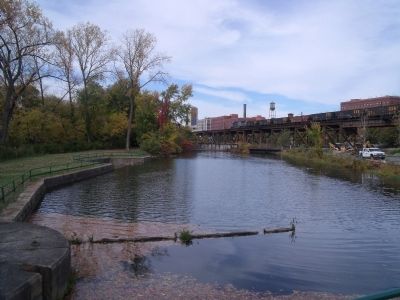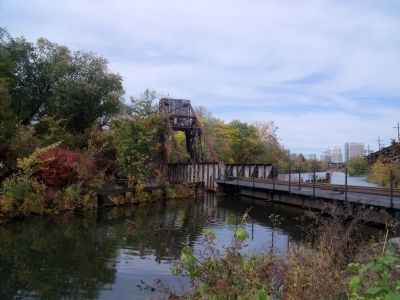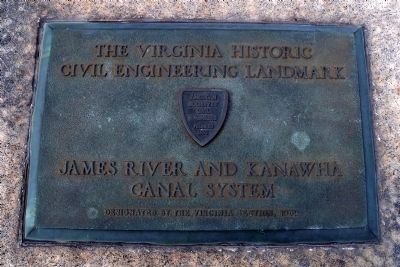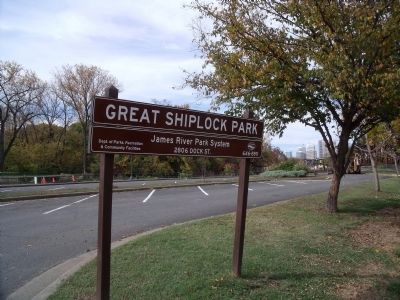Shockoe Bottom in Richmond, Virginia — The American South (Mid-Atlantic)
Great Ship Lock
The Great Ship Lock connected the navigable part of the James River with the Richmond city dock, which extended for ten blocks to the west. Ocean-going vessels were raised up from sea level to the level of the city dock which accommodated ships as large as 180 feet long by 35 feet wide. The Great Ship Lock was completed along with other canal improvements in 1854, although earlier ship locks were located in the same location.
Topics. This historical marker is listed in these topic lists: Bridges & Viaducts • Industry & Commerce • Waterways & Vessels. A significant historical year for this entry is 1854.
Location. 37° 31.554′ N, 77° 25.249′ W. Marker is in Richmond, Virginia. It is in Shockoe Bottom. Marker can be reached from the intersection of Dock Street and Pear Street. This kiosk is located at the east end of the parking lot in the Great Shiplock Park. Touch for map. Marker is at or near this postal address: 2806 Dock Street, Richmond VA 23223, United States of America. Touch for directions.
Other nearby markers. At least 8 other markers are within walking distance of this marker. Rocketts Landing (here, next to this marker); Confederate Navy Yard (a few steps from this marker); a different marker also named Great Ship Lock (a few steps from this marker); a different marker also named Great Ship Lock (within shouting distance of this marker); Coffer Dams (within shouting distance of this marker); 17 Feet (within shouting distance of this marker); Rocketts Landing and Wharf / Confederate Navy Yard / Powhatan’s Birthplace (within shouting distance of this marker); City Locks River Gauge (within shouting distance of this marker). Touch for a list and map of all markers in Richmond.
Regarding Great Ship Lock. The great lock, built between 1850-1854, connected the James River with the Richmond Dock, completing the James River and Kanawha Canal system that bypassed seven miles of falls and continued 197 miles through Virginia’s western mountain ranges.
Also see . . .
1. Great Shiplock Park and Chapel Island. Friends of the James River Park website entry (Submitted on October 26, 2009.)
2. James River and Kanawha Canal Historic District. Virginia Department of Historic Resources website entry (Submitted on September 23, 2022, by Larry Gertner of New York, New York.)
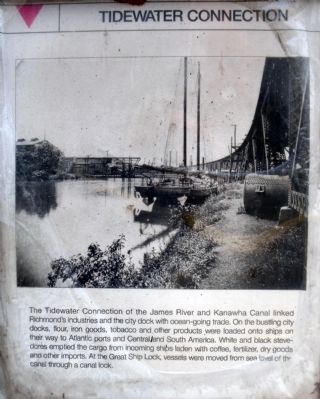
Photographed By Bernard Fisher, October 25, 2009
7. Tidewater Connection
The Tidewater Connection of the James River and Kanawha Canal linked Richmond’s industries and the city dock with ocean-going trade. On the bustling city docks, flour, iron goods, tobacco and other products were loaded onto ships on their way to Atlantic ports and Central and South America. White and black stevedores emptied the cargo from incoming ships laden with coffee, fertilizer, dry goods and other imports. At the Great Ship Lock; vessels were moved from sea level of the canal through a canal lock.
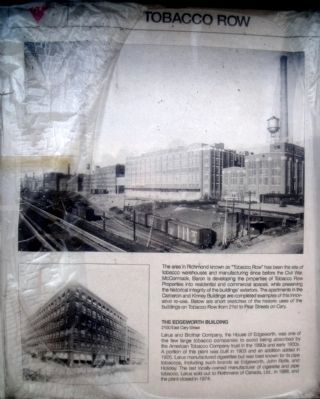
Photographed By Bernard Fisher, October 25, 2009
8. Tobacco Row
The area in Richmond known as “Tobacco Row” has been the site of tobacco warehouses and manufacturing since before the Civil War. McCormack, Baron is developing the properties of Tobacco Row Properties into residential and commercial spaces, while preserving the historical integrity of the buildings’ exteriors. The apartments in the Cameron and Kinney Buildings are completed examples of this innovative re-use. Below are short sketches of the historic uses of the buildings on Tobacco Row from 21st to Pear Streets on Cary.
THE EDGEWORTH BUILDING
2100 East Cary Street
Larus and Brother Company, the House of Edgeworth, was one of the few large tobacco companies to avoid being absorbed by the American Tobacco Company trust in the 1890s and early 1900s. A portion of this plant was built in 1903 and an addition added in 1925. Larus manufactured cigarettes but was best known for its pipe tobaccos, including such brands as Edgeworth, John Rolfe, and Holiday. The last locally-owned manufacturer of cigarette and pipe tobacco, Larus sold out to Rothmans of Canada, Ltd., in 1968, and the plant closed in 1974.
THE EDGEWORTH BUILDING
2100 East Cary Street
Larus and Brother Company, the House of Edgeworth, was one of the few large tobacco companies to avoid being absorbed by the American Tobacco Company trust in the 1890s and early 1900s. A portion of this plant was built in 1903 and an addition added in 1925. Larus manufactured cigarettes but was best known for its pipe tobaccos, including such brands as Edgeworth, John Rolfe, and Holiday. The last locally-owned manufacturer of cigarette and pipe tobacco, Larus sold out to Rothmans of Canada, Ltd., in 1968, and the plant closed in 1974.
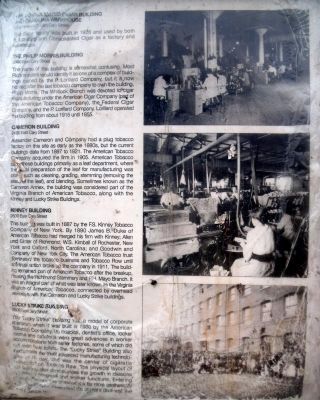
Photographed By Bernard Fisher, October 25, 2009
9. Tobacco Row (continued)
THE CONSOLIDATED CIGAR BUILDING AND CAROLINA WAREHOUSE
2200 and 2220 East Cary Street
The cigar facility was built in 1926 and used by both P. Lorillard and Consolidated Cigar as a factory and warehouse.
THE PHILIP MORRIS BUILDING
2300 East Cary Street
The name of this building is spomewaht confusing. Most Richmonders would identify it as one complex of buildings owned by the P. Lorillard Company, but it is now named after the last tobacco company to own the building, Philp Morris. The Whitlock Branch was devoted to cigar manufacturing under the American Cigar Company (part of the American Tobacco Company), the Federal Cigar Company, and the P. Lorillard Company. Lorillard operated the building from about 1915 until 1955.
CAMERON BUILDING
2400 East Cary Street
Alexander Cameron and Company had a plug tobacco factory on this site as early as the 1880s, but the current buildings date from 1897 to 1921. The American Tobacco Company acquired the firm in 1905. American Tobacco used these buildings primarily as a leaf department, where the initial preparation of the leaf for manufacturing was done, such as cleaning, grading, stemming (removing the stem of the leaf), and blending. Sometimes known as the Cameron Annex, the building was considered part of the Virginia Branch of American Tobacco, along with the Kinney and Lucky Strike Buildings.
KINNEY BUILDING
2500 East Cary Street
This building was built in 1887 by the F.S. Kinney Tobacco Company of New York. By 1890 James B. Duke of American Tobacco had merged his firm with Kinney; Allen and Ginter of Richmond; W.S. Kimball of Rochester, New York and Oxford, North Carolina; and Goodwin and Company of New York City. The American Tobacco trust dominated the tobacco business and Tobacco Row until anti-trust action broke up the company in 1911. The building remained part of American Tobacco after the breakup, housing the Richmond Stemmery and P.H. Mayo Branch. It was an integral part of what was later known as the Virginia Branch of American Tobacco, connected by overhead walkways with the Cameron and Lucky Strike buildings.
LUCKY STRIKE BUILDING
2600 East Cary Street
The “Lucky Strike” Building was a model of corporate liberalism when it was built in 1930 by the American Tobacco Company. Its hospital, dentist’ office, locker rooms and cafeteria were great advances in worker accommodations from earlier factories, some of which did not even have toilets. The “Lucky Strike” Building also incorporated the most advanced manufacturing technologies of its day, and was the center of cigarette (?) on Tobacco Row. The physical layout of the building also demonstrates the growth in divisions between managerial and worker functions. Entering (?) is a far more aesthetically pleasing (?) the worker’s doorway. The (?) closed in (?).
2200 and 2220 East Cary Street
The cigar facility was built in 1926 and used by both P. Lorillard and Consolidated Cigar as a factory and warehouse.
THE PHILIP MORRIS BUILDING
2300 East Cary Street
The name of this building is spomewaht confusing. Most Richmonders would identify it as one complex of buildings owned by the P. Lorillard Company, but it is now named after the last tobacco company to own the building, Philp Morris. The Whitlock Branch was devoted to cigar manufacturing under the American Cigar Company (part of the American Tobacco Company), the Federal Cigar Company, and the P. Lorillard Company. Lorillard operated the building from about 1915 until 1955.
CAMERON BUILDING
2400 East Cary Street
Alexander Cameron and Company had a plug tobacco factory on this site as early as the 1880s, but the current buildings date from 1897 to 1921. The American Tobacco Company acquired the firm in 1905. American Tobacco used these buildings primarily as a leaf department, where the initial preparation of the leaf for manufacturing was done, such as cleaning, grading, stemming (removing the stem of the leaf), and blending. Sometimes known as the Cameron Annex, the building was considered part of the Virginia Branch of American Tobacco, along with the Kinney and Lucky Strike Buildings.
KINNEY BUILDING
2500 East Cary Street
This building was built in 1887 by the F.S. Kinney Tobacco Company of New York. By 1890 James B. Duke of American Tobacco had merged his firm with Kinney; Allen and Ginter of Richmond; W.S. Kimball of Rochester, New York and Oxford, North Carolina; and Goodwin and Company of New York City. The American Tobacco trust dominated the tobacco business and Tobacco Row until anti-trust action broke up the company in 1911. The building remained part of American Tobacco after the breakup, housing the Richmond Stemmery and P.H. Mayo Branch. It was an integral part of what was later known as the Virginia Branch of American Tobacco, connected by overhead walkways with the Cameron and Lucky Strike buildings.
LUCKY STRIKE BUILDING
2600 East Cary Street
The “Lucky Strike” Building was a model of corporate liberalism when it was built in 1930 by the American Tobacco Company. Its hospital, dentist’ office, locker rooms and cafeteria were great advances in worker accommodations from earlier factories, some of which did not even have toilets. The “Lucky Strike” Building also incorporated the most advanced manufacturing technologies of its day, and was the center of cigarette (?) on Tobacco Row. The physical layout of the building also demonstrates the growth in divisions between managerial and worker functions. Entering (?) is a far more aesthetically pleasing (?) the worker’s doorway. The (?) closed in (?).
Credits. This page was last revised on September 2, 2023. It was originally submitted on October 26, 2009, by Bernard Fisher of Richmond, Virginia. This page has been viewed 2,634 times since then and 36 times this year. Photos: 1, 2, 3, 4, 5, 6, 7, 8, 9, 10, 11. submitted on October 26, 2009, by Bernard Fisher of Richmond, Virginia.
